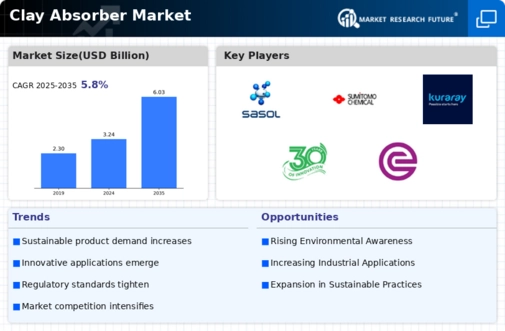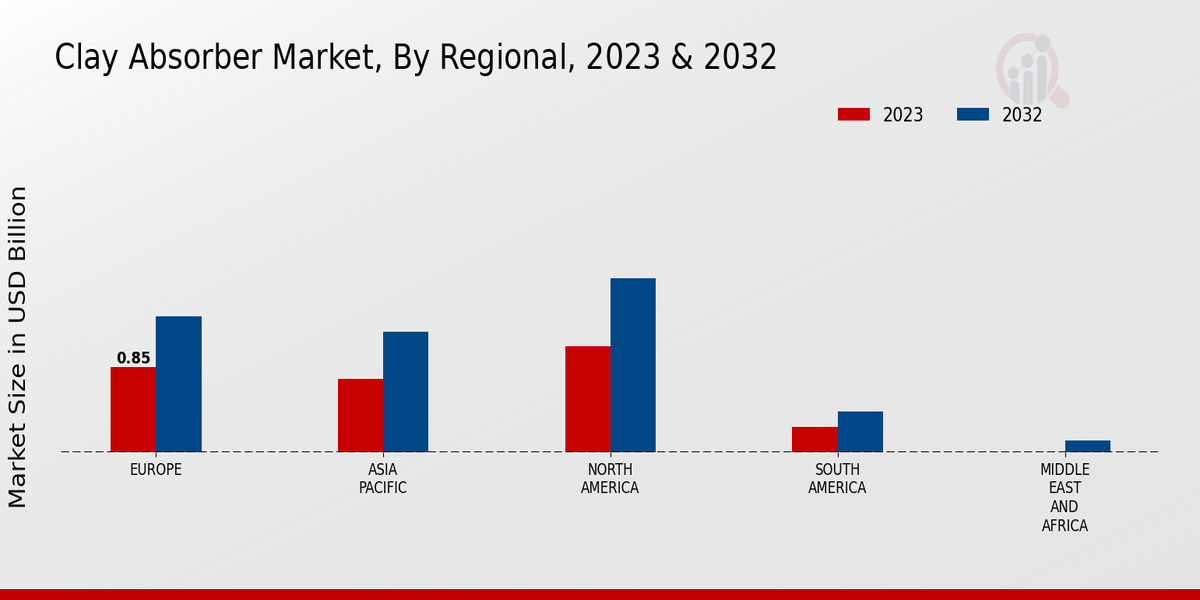Market Growth Projections
The Global Clay Absorber Market Industry is projected to experience substantial growth over the next decade. With an estimated market value of 3.24 USD Billion in 2024, the industry is expected to expand significantly, reaching approximately 6.03 USD Billion by 2035. This growth trajectory suggests a compound annual growth rate of 5.81% from 2025 to 2035. The increasing demand for clay absorbers across various applications, coupled with advancements in production technologies and regulatory support, indicates a robust market outlook. These projections highlight the potential for investment and innovation within the clay absorber sector.
Expansion of Industrial Applications
The Global Clay Absorber Market Industry is witnessing an expansion in its industrial applications, particularly in sectors such as construction, agriculture, and environmental remediation. Clay absorbers are utilized for their excellent adsorption properties, making them ideal for controlling moisture and pollutants. For instance, in agriculture, they enhance soil quality and water retention, which is crucial for crop yield. This diversification of applications is likely to contribute to the market's growth trajectory, with projections indicating a rise to 6.03 USD Billion by 2035. The versatility of clay absorbers positions them as essential materials across various industries.
Technological Advancements in Production
Technological advancements in the production of clay absorbers are playing a crucial role in the Global Clay Absorber Market Industry. Innovations in extraction and processing techniques have improved the efficiency and effectiveness of clay absorbers, making them more competitive against synthetic alternatives. Enhanced production methods can lead to cost reductions and improved product quality, which may attract a broader customer base. As the industry embraces these advancements, it is poised for growth, with a projected compound annual growth rate of 5.81% from 2025 to 2035. This technological evolution is essential for meeting the increasing demand for high-performance clay absorbers.
Increasing Demand for Eco-Friendly Products
The Global Clay Absorber Market Industry is experiencing a notable surge in demand for eco-friendly products. As consumers become more environmentally conscious, there is a growing preference for natural and biodegradable materials. Clay absorbers, derived from natural clay minerals, align with this trend, offering sustainable solutions for various applications, including oil spill cleanup and industrial waste management. This shift towards sustainability is expected to drive market growth, with the industry projected to reach 3.24 USD Billion in 2024. Companies that prioritize eco-friendly practices may find themselves at a competitive advantage in this evolving landscape.
Regulatory Support for Environmental Protection
The Global Clay Absorber Market Industry benefits from increasing regulatory support aimed at environmental protection. Governments worldwide are implementing stricter regulations regarding waste management and pollution control, which encourages the adoption of clay absorbers. For example, regulations mandating the use of natural absorbents in oil spill response initiatives are driving demand for clay-based products. This regulatory landscape not only fosters market growth but also enhances the credibility of clay absorbers as effective solutions for environmental challenges. As regulations evolve, the industry is likely to see sustained growth, aligning with global sustainability goals.
Rising Awareness of Health and Safety Standards
The Global Clay Absorber Market Industry is influenced by rising awareness of health and safety standards across various sectors. Industries are increasingly recognizing the importance of using safe and non-toxic materials in their operations. Clay absorbers, known for their natural composition and minimal environmental impact, are becoming preferred choices in applications ranging from food processing to pharmaceuticals. This heightened awareness is likely to drive market growth as companies seek to comply with stringent health regulations. The trend towards safer materials aligns with the broader movement towards sustainability and responsible manufacturing practices.







